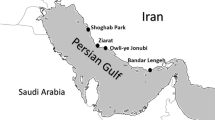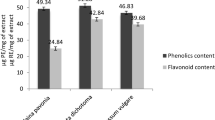Abstract
Osmundea pinnatifida is a red edible seaweed known as pepper dulse. O. pinnatifida was cultivated in the farm of ALGAplus (Ilhavo, Portugal). This farm is integrated with a seabream and seabass commercial aquaculture and uses the nutrient-enriched water resultant from the fish production as its cultivation medium in the integrated multi-trophic aquaculture (IMTA) manner. Wild and IMTA-cultivated samples of O. pinnatifida were screened for antioxidant and antitumor activities. The antioxidant capacity of solvent extracts from wild and IMTA cultivated samples was assessed in two methods (2,2-diphenyl-1-picrylhydrazyl (DPPH) and oxygen radical absorbance capacity (ORAC)), and their total phenolic contents (TPC) were estimated. Antitumor activity was evaluated in three different tumor cell lines (HepG-2, MCF-7, and SH-SY5Y) through 3-(4,5-dimethylthiazol-2-yl)-2,5-diphenyltetrazolium bromide (MTT) assay. Among the solvents used for extraction, dichloromethane was the most effective to extract phenolic compounds and presented higher ORAC. A significant correlation was found between TPC and ORAC, which was also sustained by the principal components analysis (PCA). Dichloromethane extracts induced a cytostatic effect on MCF-7 cells and showed weak cytotoxicity to SH-SY5Y cells and weak impact on cell proliferation. Overall, there were no statistically significant differences in the biological activities shown by the wild and IMTA-cultivated samples. Hence, O. pinnatifida can be obtained in an economical and environmentally sustainable way through IMTA, maintaining bioactive properties in a high potential for further nutraceutical purposes.
Similar content being viewed by others
References
Abreu M H, Pereira R, Yarish C, Buschmann A H, Sousa-Pinto I. 2011. IMTA with Gracilaria vermiculophylla: productivity and nutrient removal performance of the seaweed in a land-based pilot scale system. Aquaculture, 312(1–4): 77–87, https://doi.org/10.1016/j.aquaculture.2010.12.036.
Abu-Dahab R, Afifi F. 2007. Antiproliferative activity of selected medicinal plants of Jordan against a breast adenocarcinoma cell line (MCF7). Scientia Pharmaceutical, 75(3): 121–136, https://doi.org/10.3797/scipharm.2007.75.121.
Airanthi M K W A, Hosokawa M, Miyashita K. 2011. Comparative antioxidant activity of edible Japanese brown seaweeds. Journal of Food Science, 76(1): C104–C111, https://doi.org/10.1111/j.1750-3841.2010.01915.x.
Alves C, Pinteus S, Horta A, Pedrosa R. 2016. High cytotoxicity and anti-proliferative activity of algae extracts on an in vitro model of human hepatocellular carcinoma. SpringerPlus, 5(1): 1 339, https://doi.org/10.1186/s40064-016-2938-2.
American Cancer Society. 2018. Cancer facts & figures 2018. https://doi.org/www.cancer.org/content/dam/cancer-org/research/cancer-facts-and-statistics/annual-cancer-facts-and-figures/2018/cancer-facts-and-figures-2018.pdf. Accessed on 2018-02-10.
Bae H, Jayaprakasha G K, Crosby K, Jifon J L, Patil B S. 2012. Influence of extraction solvents on antioxidant activity and the content of bioactive compounds in non-pungent peppers. Plant Foods for Human Nutrition, 67(2): 120–128, https://doi.org/10.1007/s11130-012-0290-4.
Barreto M C, Mendonça E, Gouveia V, Anjos C, Medeiros J S, Seca A M L, Neto A I. 2012. Macroalgae from S. Miguel Island as a potential source of antiproliferative and antioxidant products. Arquipelago Life Mar. Sci, 29: 53–58.
Bedoux G, Hardouin K, Burlot A S, Bourgougnon N. 2014. Bioactive components from seaweeds: cosmetic applications and future development. Advances in Botanical Research, 71: 345–378.
Burtin P. 2003. Nutritional value of seaweeds. Electron. J. Environ. Agric. Food Chem., 2: 498–503.
Cardoso S M, Carvalho L G, Silva P J, Rodrigues M S, Pereira O R, Pereira L. 2014. Bioproducts from seaweeds: a review with special focus on the Iberian Peninsula. Current Organic Chemistry, 18(7): 896–917, https://doi.org/10.2174/138527281807140515154116.
Dai J, Mumper R J. 2010. Plant phenolics: extraction, analysis and their antioxidant and anticancer properties. Molecules, 15(10): 7 313–7 352, https://doi.org/10.3390/molecules15107313.
Dávalos A, Gómez-Cordovés C, Bartolome B. 2004. Extending applicability of the oxygen radical absorbance capacity (ORAC-fluorescein) assay. Journal of Agricultural and Food Chemistry, 52(1): 48–54, https://doi.org/10.1021/jf0305231.
De Quirós A R B, Lage-Yusty M A, López-Hernández J. 2010. Determination of phenolic compounds in macroalgae for human consumption. Food Chemistry, 121(2): 634–638, https://doi.org/10.1016/j.foodchem.2009.12.078.
Foo SC, Yusoff F M, Ismail M, Basri M, Yau S K, Khong M H, Chan K W, Ebrahimi M. 2017. Antioxidant capacities of fucoxanthin-producing algae as influenced by their carotenoid and phenolic contents. Journal of Biotechnology, 241: 175–183, https://doi.org/10.1016/j.jbiotec.2016.11.026.
Ganesan P, Kumar C S, Bhaskar N. 2008. Antioxidant properties of methanol extract and its solvent fractions obtained from selected Indian red seaweeds. Bioresource Technology, 99(8): 2 717–2 723, https://doi.org/10.1016/j.biortech.2007.07.005.
GBD 2015 Mortality and Causes of Death Collaborators. 2016. Global, regional, and national life expectancy, all-cause mortality, and cause-specific mortality for 249 causes of death, 1980-2015: a systematic analysis for the Global Burden of Disease Study 2015. Lancet, 388(10053): 1 459–1 544, https://doi.org/10.1016/S0140-6736(16)31012-1.
Herald T J, Gadgil P, Tilley M. 2012. High-throughput micro plate assays for screening flavonoid content and DPPH-scavenging activity in sorghum bran and flour. Journal of the Science of Food and Agriculture, 92(11): 2 326–2 331, https://doi.org/10.1002/jsfa.5633.
Holdt S L, Kraan S. 2011. Bioactive compounds in seaweed: functional food applications and legislation. Journal of Applied Phycology, 23(3): 543–597, https://doi.org/10.1007/s10811-010-9632-5.
Huang D J, Ou B X, Prior R L. 2005. The chemistry behind antioxidant capacity assays. Journal of Agricultural and Food Chemistry, 53(6): 1 841–1 856, https://doi.org/10.1021/jf030723c.
Ibanez E, Herrero M, Mendiola JA, Castro-Puyana M. 2012. Extraction and characterization of bioactive compounds with health benefits from marine resources: macro and micro algae, cyanobacteria, and invertebrates. In: Hayes M ed. Marine Bioactive Compounds. Springer US, Boston, MA. p.55–98.
Ito K, Hori K. 1989. Seaweed: chemical composition and potential food uses. Food Reviews International, 5(1): 101–144, https://doi.org/10.1080/87559128909540845.
Juagdan E G, Kalidindi R, Scheuer P. 1997. Two new chamigranes from an hawaiian red alga, Laurencia cartilaginea. Tetrahedron, 53(2): 521–528, https://doi.org/10.1016/S0040-4020(96)01002-2.
Lee J C, Hou M F, Huang H W, Chang F R, Yeh C C, Tang J Y, Chang H W. 2013. Marine algal natural products with anti-oxidative, anti-inflammatory, and anti-cancer properties. Cancer Cell International, 13: 55, https://doi.org/10.1186/1475-2867-13-55.
Lesjak M, Beara I, Simin N, Pintac D, Majkić T, Bekvalac K, Orčić D, Mimica-Dukić N. 2018. Antioxidant and anti-inflammatory activities of quercetin and its derivatives. Journal of Functional Foods, 40: 68–75, https://doi.org/10.1016/j.jff.2017.10.047.
Liu Z, Romero-Canelón I, Qamar B, Hearn J M, Habtemariam A, Barry N P E, Pizarro A M, Clarkson G J, Sadler P J. 2014. The potent oxidant anticancer activity of organoiridium catalysts. Angew Chemie, 53(15): 3 941–3 946, https://doi.org/10.1002/anie.201311161.
Martins A, Vieira H, Gaspar H, Santos S. 2014. Marketed marine natural products in the pharmaceutical and cosmeceutical industries: tips for success. Marine Drugs, 12(2): 1 066–1 101, https://doi.org/10.3390/md12021066.
Murphy C, Hotchkiss S, Worthington J, McKeown S R. 2014. The potential of seaweed as a source of drugs for use in cancer chemotherapy. Journal of Applied Phycology, 26(5): 2 211–2 264, https://doi.org/10.1007/s10811-014-0245-2.
Nogueira C C, Paixão I C, Teixeira V L. 2014. Antioxidant activity of natural products isolated from red seaweeds. Natural Product Communications, 9(7): 1 031–1 036.
Norte M, Fernández J J, Souto M L, Gavín J A, García-Grávalos M D. 1997. Thyrsenols A and B, two unusual polyether squalene derivatives. Tetrahedron, 53(9): 3 173–3 178, https://doi.org/10.1016/S0040-4020(97)00028-8.
Paiva L S, Patarra R F, Neto A I, Emc L, Jab B. 2012. Antioxidant activity of macroalgae from the Azores. Arquipelago Life Mar. Sci., 29: 1–6.
Paiva L, Lima E, Patarra R F, Neto A I, Baptista J. 2014. Edible Azorean macroalgae as source of rich nutrients with impact on human health. Food Chemistry, 164: 128–135, https://doi.org/10.1016/j.foodchem.2014.04.119.
Pangestuti R, Kim S K. 2011. Neuroprotective effects of marine algae. Marine Drugs, 9(5): 803–818.
Park E J, Pezzuto J M. 2013. Antioxidant marine products in cancer chemoprevention. Antioxidants & Redox Signaling, 19(2): 115–138, https://doi.org/10.1089/ars.2013.5235.
Patarra R F, Leite J, Pereira R, Baptista J, Neto A I. 2013. Fatty acid composition of selected macrophytes. Natural Product Research, 27(7): 665–669, https://doi.org/10.1080/14786419.2012.688048.
Pereira L. 2016. Edible Seaweeds of the World. Science Publishers’ (SP), an Imprint of CRC Press/Taylor & Francis Group, Boca Raton, FL. 448p.
Pereira L. 2018. Therapeutic and Nutritional Uses of Algae. CRC PressBoca Raton, FL. 640p.
Pinteus S, Silva J, Alves C, Horta A, Thomas O P, Pedrosa R. 2017. Antioxidant and cytoprotective activities of fucus spiralis seaweed on a human cell in vitro model. International Journal of Molecular Sciences, 18(2): 292, https://doi.org/10.3390/ijms18020292.
Pomponi S A. 2001. Roger revelle commemorative lecture-the oceans and human health: the discovery and development of marine-derived drugs. Oceanography, 14(1): 78–87.
Rodrigues D, Freitas A C, Pereira L, Rocha-Santos T A P, Vasconcelos M W, Roriz M, Rodriguez-Alcala L M, Gomes A M P, Duarte A C. 2015b. Chemical composition of red, brown and green macroalgae from Buarcos bay in Central West Coast of Portugal. Food Chemistry, 183: 197–207, https://doi.org/10.1016/j.foodchem.2015.03.057.
Rodrigues D, Sousa S, Silva A, Amorim M, Pereira L, Rocha-Santos T A P, Gomes A M P, Duarte A C, Freitas A C. 2015a. Impact of enzyme- and ultrasound-assisted extraction methods on biological properties of red, brown, and green seaweeds from the central west coast of Portugal. Journal of Agricultural and Food Chemistry, 63(12): 3 177–3 188, https://doi.org/10.1021/jf504220e.
Rodrigues D, Walton G, Sousa S, Rocha-Santos T A P, Duarte A C, Freitas A C, Gomes A M P. 2016. In vitro fermentation and prebiotic potential of selected extracts from seaweeds and mushrooms. LWT, 73: 131–139, https://doi.org/10.1016/j.lwt.2016.06.004.
Sathya R, Kanaga N, Sankar P, Jeeva S. 2017. Antioxidant properties of phlorotannins from brown seaweed Cystoseira trinodis (Forsskâl) C. Agardh. Arabian Journal of Chemistry, 10(S2): S2 608–S2 614, https://doi.org/10.1016/j.arabjc.2013.09.039.
Silva P J, Alves C, Pinteus S, Silva J, Valado A, Pedrosa R, Pereira L. 2017. Screening of Biotechnological Potential of wild and IMTA-Cultivated Osmundea Pinnatifida (Rhodophyta). P1. 33, 7th International Conference on Algal Biomass, Biofuels & Bioproducts. 18–21 June 2017, Miami, FL.
Smit A J. 2004. Medicinal and pharmaceutical uses of seaweed natural products: a review. Journal of Applied Phycology, 16(4): 245–262, https://doi.org/10.1023/B:JAPH.0000047783.36600.ef.
Sudha A, Jeyakanthan J, Srinivasan P. 2017. Green synthesis of silver nanoparticles using Lippia nodiflora aerial extract and evaluation of their antioxidant, antibacterial and cytotoxic effects. Resource-Efficient Technologies, 3(4): 506–515, https://doi.org/10.1016/j.reffit.2017.07.002.
Tsimberidou A M. 2015. Targeted therapy in cancer. Cancer Chemotherapy and Pharmacology, 76(6): 1 113–1 132, https://doi.org/10.1007/s00280-015-2861-1.
Wang T, Jönsdöttir R, Ólafsdöttir G. 2009. Total phenolic compounds, radical scavenging and metal chelation of extracts from Icelandic seaweeds. Food Chemistry, 116(1): 240–248, https://doi.org/10.1016/j.foodchem.2009.02.041.
Wojcikowski K, Stevenson L M, Leach D N, Wohlmuth H, Gobe G. 2007. Antioxidant capacity of 55 medicinal herbs traditionally used to treat the urinary system: a comparison using a sequential three-solvent extraction process. Journal of Alternative and Complementary Medicine, 13(1): 103–109, https://doi.org/10.1089/acm.2006.6122.
Zou Y P, Chang S K C, Gu Y, Qian S Y. 2011. Antioxidant activity and phenolic compositions of lentil (Lens culinaris var. Morton) extract and its fractions. Journal of Agricultural & Food Chemistry, 59(6): 2 268–2 276, https://doi.org/10.1021/jf104640k.
Zulueta A, Esteve M J, Frigola A. 2009. ORAC and TEAC assays comparison to measure the antioxidant capacity of food products. Food Chemistry, 114(1): 310–316, https://doi.org/10.1016/j.foodchem.2008.09.033.
Acknowledgment
This work had the support of Fundaçào para a Ciência e Tecnologia (FCT), through the strategic project (No. UID/MAR/04292/2013) granted to MARE. This work had also the support from the European Union through EASME Blue Labs project AMALIA—Algae-to-MArket Lab IdeAs (No. EASME/EMFF/2016/1.2.1.4/03/SI2.750419). Received funding from European Structural & Investment Funds through the COMPETE Programme and from National Funds through FCT—Fundação para a Ciência e a Tecnologia under the Programme (No. SAICTPAC/0019/2015).
Author information
Authors and Affiliations
Corresponding author
Rights and permissions
About this article
Cite this article
Silva, J.P., Alves, C., Pinteus, S. et al. Antioxidant and antitumor potential of wild and IMTA-cultivated Osmundea pinnatifida. J. Ocean. Limnol. 37, 825–835 (2019). https://doi.org/10.1007/s00343-019-8110-4
Received:
Accepted:
Published:
Issue Date:
DOI: https://doi.org/10.1007/s00343-019-8110-4




